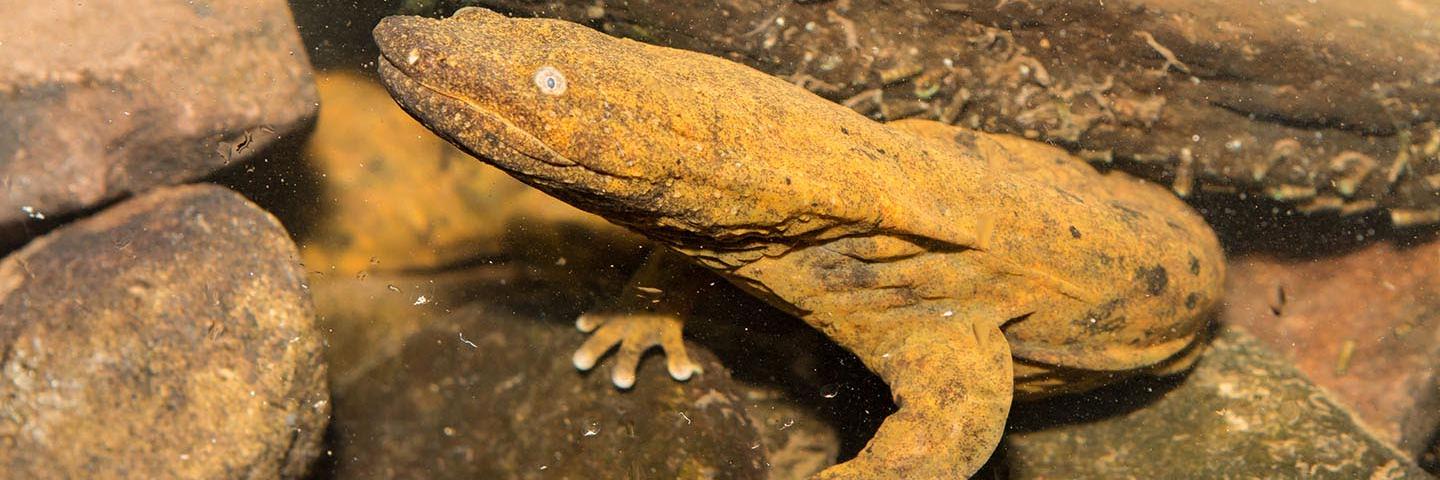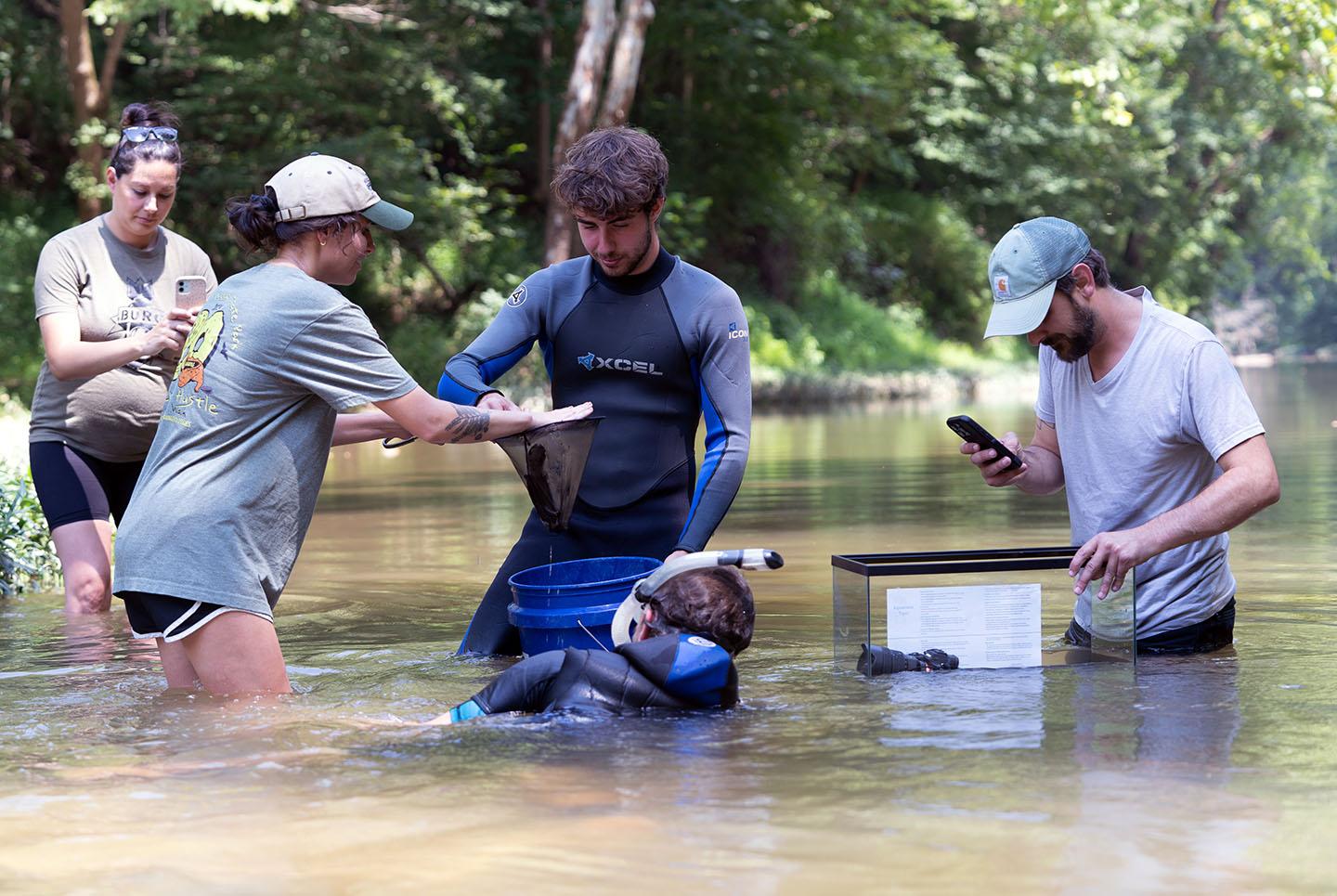Rebuilding Indiana’s Hellbender Habitat

The Farmers Helping Hellbenders project, bolstered by the NRCS Regional Conservation Partnership Program, aims to improve water quality and restore the hellbender population in the Blue River-Sinking watershed. Read about the project successes.
Nestled within the cool, flowing waters of Indiana's Blue River, the elusive hellbender thrives under big, flat rocks, seeking refuge from predators and finding the perfect conditions to lay their eggs. But in recent years, they have become increasingly difficult to find.
Hellbenders used to have a much larger range, occurring in most of southeast Indiana’s tributaries to the Ohio River and in the Wabash River. Sadly, its population has dropped drastically due to modification of stream habitats including the accumulation of sediment, agricultural and industrial pollution, warming waters and the channelization of streams and rivers. Because of their decline, these endangered ancient amphibians, with their large, unique flat bodies, have become the focus of an ambitious conservation effort led by Purdue University.
“The significance of the hellbender and its conservation extends beyond the species itself,” Purdue Extension Wildlife Specialist, Nick Burgmeier explains. “Hellbenders are an indicator species; their presence reflects the health of the water quality. Historically common and a top predator in streams, their decline has ecological repercussions, particularly on crayfish populations, which can disrupt food webs.”
The Farmers Helping Hellbenders project, bolstered by the USDA-Natural Resources Conservation Service’s (NRCS) Regional Conservation Partnership Program (RCPP), aims to improve water quality and restore the hellbender population in the Blue River-Sinking watershed. RCPP is a partner-driven approach to conservation that funds solutions to natural resource challenges on agricultural land. By leveraging collective resources and collaborating on common goals, RCPP projects like Farmers Helping Hellbenders, demonstrates the power of public-private partnerships in delivering results for agriculture and conservation. And unlike broader financial assistance programs, RCPP funds are targeted specifically for partner-driven, locally led conservation, like the work happening in the Blue River-Sinking watershed, ensuring a significant, localized impact.

"I think what's really important about having an RCPP project in this area is that the financial incentives are targeted only for land located in the watershed. So only folks in the Blue River-Sinking watershed are eligible to receive this funding," Farmers Helping Hellbenders Project Coordinator, Eliza Hudson explains. "Because of that focused funding, we can have a really big impact on water quality for hellbenders and wildlife in general."
The overarching goals of the Farmers Helping Hellbenders project are twofold: improving hellbender habitat and enhancing local farming operations.
"We want to obviously improve hellbender habitat, which includes improving water quality and making sure that we're reducing the amount of sediment, nutrients and pesticides that are getting into the river," Hudson notes. "Secondly, a big goal is to make sure we're improving local farming operations by keeping soil and nutrients where they are."
Farmers play a crucial role in this conservation effort by adopting practices that enhance water quality and habitat conditions. Hudson highlights popular agronomy practices like cover crops, nutrient management, field borders, and filter strips. Livestock practices such as heavy use area protection, water facilities and fencing are also commonly used. Moving forward, the project aims to focus on riparian buffers, which research shows are vital for water quality and hellbender reproduction.
Despite being in the early stages, the project has already seen successes. In 2023, four contracts to implement conservation practices within the watershed were obligated. The environmental impact is notable, with an estimated reduction of sediment loading by over 533,000 pounds per year from just one farm that included about 1,400 acres of cover crops and nutrient management.
But landowners are not the only vital players in this project. Partners are also fundamental to the project's existence and success. Hudson acknowledges the contributions of 14 partnering organizations, ranging from financial support to unique contributions like raising juvenile hellbenders for release. The Indianapolis Zoo, Fort Wayne Children’s Zoo and Mesker Park Zoo and Botanical Gardens are playing a pivotal role in this effort, raising juveniles whose release into the Blue River-Sinking watershed is critical for population recovery. Additionally, although not official partners of the project, the Ohio Department of Natural Resources and the Kentucky Department of Fish and Wildlife Resources play a crucial role in the broader partnership by providing the eggs these zoos rear for eventual release into Indiana.
Beyond being the project’s lead sponsor, Purdue University's involvement in hellbender research and conservation is extensive. Their efforts include captive rearing research to improve post-release survival and basic science research on the interactions between hellbenders and other aquatic species. This comprehensive approach, with a focus on releasing animals back into streams, aims to restore hellbender populations to self-sustaining levels.
Since 2017, Purdue University has been releasing juvenile hellbenders back into Indiana waters. The release of hellbenders into the wild is a meticulous process. Burgmeier describes the use of soft releases, where hellbenders are acclimated to their new environment in cages before being set free. This method significantly improves their chances of staying in the release area and successfully integrating into the ecosystem.
Since their initial release in 2017, Purdue University has reintroduced approximately 500 juveniles into the Blue River. This year alone, they plan to release over 300 animals and over the next several years, they will release anywhere between 100 to 300 animals annually.
“The hellbender is a very ancient species. Once it's gone, we don't get that opportunity to bring it back,” said Burgmeier. “We consider this species an umbrella species, so everything that's required to protect hellbenders, protects pretty much all the other things.”
As conservationists like Hudson and Burgmeier continue their dedicated efforts to help farmers improve their operations while improving water quality within the Blue River-Sinking watershed, the future of the hellbender in Indiana looks hopeful. Through targeted financial assistance, collaborative partnerships, and innovative research, the hellbender's habitat is being restored, ensuring that this ancient species can once again thrive in the waters of the Blue River.
"I love the NRCS mission of being able to help people help the land, and I think being able to do that in such a way where we're focusing on one specific endangered species, it's incredibly gratifying, because we're seeing the work that we're doing make a difference in real-time,” reflected Hudson.
In November 2023, NRCS announced more than $1 billion for 81 RCPP projects across the country. View the interactive map of awarded projects here.
Partnering agencies include: Crawford County Cattleman's Association, Crawford County Soil and Water Conservation District, Cryptobranchid Interest Group, Floyd County Soil and Water Conservation District, Fort Wayne Children's Zoo, Harrison County Cattleman's Association, Harrison County Soil and Water Conservation District, Indiana Department of Environmental Management, Indianapolis Zoo, Mesker Park Zoo and Botanic Garden, The Nature Conservancy, Wallace Center at Winrock International, Washington County Cattleman's and Washington County Soil and Water Conservation District.

